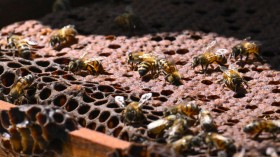Although the mad rush to snatch up those last minute Christmas gifts and Black Friday sales may make your bank account seem like a dark and empty abyss, you may have missed out on the true black holes that NASA was showcasing yesterday. Here's a recap.
This past Friday NASA decided to have their own Black Friday, as "Black Hole Friday," answering some of the most basic questions about these intergalactic enigmas.
First, and foremost, it's important to point out that while most astronomers and astrophysicists are convinced that black holes exist, they have never actually seen one. That's because black holes are so dense and their gravitational pull is so powerful that not even light escapes them. Instead, we "see" them by observing how the surrounding matter is affected.
Traditionally, gravitational pull is based off the density and mass of an object, where a ball of iron in space will have a slightly stronger pull than a baseball of the same size. However, in the case of black holes, density is clocked up well beyond the characteristic of a standard celestial object. Even the smallest black holes (theorized to be size of a single atom) can contain the mass of a large mountain, resulting in a stunning amount of gravitational pull, NASA reported.
These smallest black holes are thought to have only been created during the Big Bang. However, other high energy explosions - like the death throes of a collapsing star (supernova) - can create the "younger" stellar and "supermassive" black holes that are found at the center of galaxies.
The pull of a stellar black hole is thought to be what gives a galaxy is circular and often spiral shape, where our own Milky Way galaxy centers around a supermassive. (Scroll to read on...)
Scratching our Heads
Now here's where things get tricky. Because we can't actually directly observe these mysterious objects, we know very little about black holes, despite the fact that they are so important to galaxy formation.
Many recent studies have revealed that a startling number of black holes don't appear to be one-way-streets, and are actually pumping out radiation and even gas as they continue to suck down matter.
Blazars for instance - the highest-energy type of active galaxy in the universe - can run off of two unusual types of massive black holes that appear to collect gas, only to fire some of it out in jet streams that almost approach the speed of light.
Back in June, researcher revealed that a very unique supermassive 244.6 million light years from Earth, NGC 5584, has been firing streams of relatively cold gas and various rays from its center in unpredictable patterns, setting it apart from blazars.
Then, just this month, a team of experts using the IceCube Neutrino Observatory and a number of x-ray telescopes discovered that our own Milky Way black hole appears to be pumping out neutrino particles - the mysterious "ghosts" of the particle world.
This could imply that black holes are less like pits, and more like factories, somehow converting matter into something new in unpredictable ways. (Scroll to read on...)
[credit: NASA's Goddard Space Flight Center]
The "Impossible" Reality
However, it's important to note that not everyone believes these elusive and mysterious object are even real.
Laura Mersini-Houghton, a physicist at the University of North Carolina at Chapel Hill claims to have recently found mathematical proof that black holes shouldn't be able to exist.
The researcher had been working on a fundamental problem with physics - the fact that our theories of gravity and quantum mechanics clash - for decades. However, in a new proof that appears to bring these theories together in flawless harmony, black holes can no longer fit into the picture.
That's because, according to this theory, stars would shed Hawking radiation (initial proposed by physicist Stephen Hawking) and mass as they die. A dying star would shed so much mass, in theory, that it would no longer have the density to become a black hole - leaving these precursors to galaxy formation impossible.
"I'm still not over the shock," Mersini-Houghton said in a statement. "We've been studying this problem for a more than 50 years and this solution gives us a lot to think about."
This certainly doesn't mean it's 'back to the drawing board' for astrophysics, but as we continue to learn more and more about these strange and alluring holes in space, it may be good to maintain some skepticism.
For more great nature science stories and general news, please visit our sister site, Headlines and Global News (HNGN).
© 2024 NatureWorldNews.com All rights reserved. Do not reproduce without permission.




